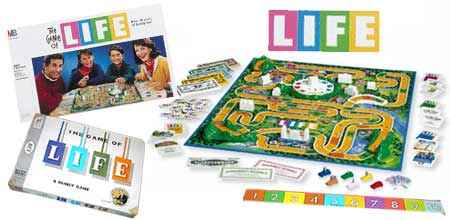Life

Synopsis of Toy
Should you go to college or throw yourself right into the jaws of the work force? Should you buy that pricey insurance or throw caution to the wind and live on the edge? Should you let the sad fact that your marriage has gotten cold and quiet get you down? These are some of Life’s pressing questions…Life, the Milton Bradley board game that is. And don’t worry: your marriage is that way because you and your mate are little plastic pegs, not because the magic is gone.
In the mid-19th century, Massachusetts lithographer Milton Bradley printed up some copies of a game he had invented called “The Checkered Game of Life.” He promoted it as an amusement both fun and educational, and it was a quick success—a better seller than his pocket-sized “Games of Soldiers” travel kits, which he marketed to Civil War soldiers, and better than his quiz games, the earliest descendants of today’s Trivial Pursuit. The Checkered Game eventually went into hibernation, but in 1959, the brass at Milton Bradley wanted something special for the company’s 100th anniversary. They hired a toy inventor named Reuben Klamer, and Reuben happened upon the old Checkered Game in the Milton vaults. He re-vamped it for a 1960 release, and a hundred years later, the game found an audience once again. Art Linkletter endorsed it back in the 60’s—his picture can be found on the cardboard game boxes of old—and millions have played it since.
When anywhere from two to six Lifers (yes, Virginia, that word is a part of prison patois, but we’re talking games here, not incarceration) sat down at the board, they chose a car, inserted a tiny plastic peg (pink or blue) into one of the slots, and collected ten thousand dollars in start-up money from whichever player had been designated as the banker. Then, the Lifers took turns spinning the dial, and whoever spun the highest number went first—the game of Life is officially on. One of the first decisions a player made was whether to attend college (for which he or she must borrow forty grand from the bank, but will then have a wider choice of careers to choose from), or dive into the nine-to-five rat race straightaway (for which he draws one Career and Salary Card each, and is stuck with whatever he draws).
As players moved through the winding course, they landed on colored squares that represented life’s bigger choices and events. Red spaces represented job searches, marriage, or buying a house; green payday spaces let you can collect your salary from the bank; orange spaces meant you followed directions; blue spaces meant you could follow directions or not; Life Spaces consisted of family activities, community service, good deeds; Career Spaces meant you either paid your opponents or the bank the amount of noted on the board (if you find yourself in a ski accident, you pay a fee to whichever player has the Doctor Career Card, and if no one you’re playing with is a Doctor, then you pay the bank; if you land on Taxes Due, you pay the Accountant, etc.).
A Lifer could land on a Baby Boy or a Baby Girl space, which meant he added an appropriately colored peg to his carload, and two pegs if he landed on a Twins space. He could buy auto insurance, homeowner’s insurance or stocks, if he so chose. If he found himself short on cash and long on colored pegs to support, then he might just have had to take out a loan from the bank, which he then had to pay back with interest—there aren’t any free lunches in life, or in Life. At some point, night school and a career change might be of interest. But then again, he might get fired or endure a mid-life crisis—and believe us, he’d never get his peg mate to talk to him after that.
At the end of the road, Retirement awaited. When a Lifer reacheed this crossroads, he repaid his loans and parked the car in Countryside Acres or the ritzy Millionaire Estates, if he thought he had more money than has opponents. When everyone else had joined him, all the players counted their money, their stocks, their life insurance…and surprise, the Lifer with the most loot won.
Milton Bradley updated Life in 1992 to reward players for modern good deeds, like recycling their trash, learning CPR and saying no to drugs. Now, by performing these good deeds, "Life" cards are earned, which can yield hefty cash bonuses come retirement time (who said kindness was its own reward?). But the peg-mates and the “should I or shouldn’t I” insurance woes? Those aren’t going anywhere, sport. Today, Life is published in over twenty different languages, and is part of the Smithsonian’s permanent collection of American History.
While Monopoly offers a foray into the adult worlds of business and real estate, Life goes one better. It offers a foray into the whole darn adult world—life lessons, lifestyle—hopefully, the life o’ Reilly—it’s all here. Take a peg seat in the peg car, and let’s get busy livin’.
Release History of Toy
1860's - "The Checkered Game of Life"1960 - Life
Sub Categories of Toys
gamesboard games
